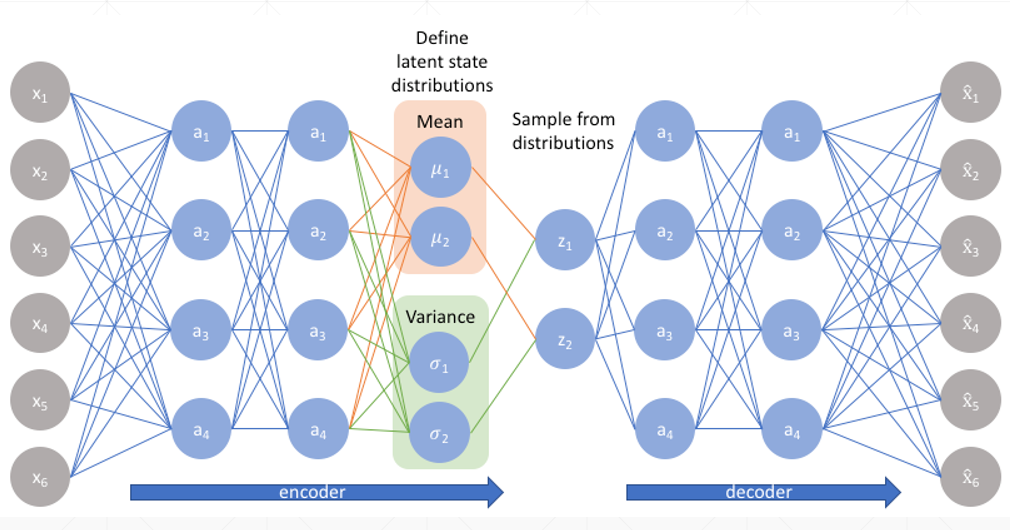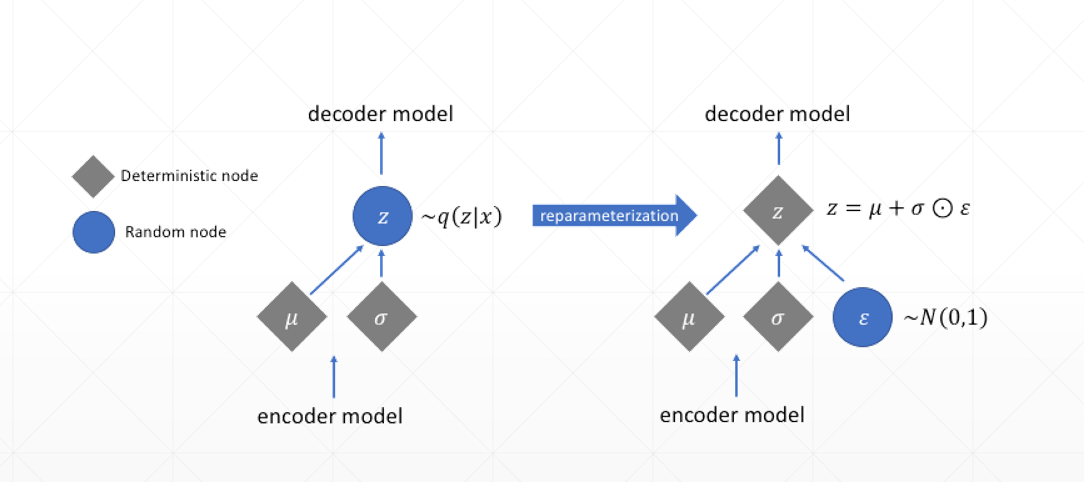1、Auto-Encoder
降到自定义层

1 import os 2 import tensorflow as tf 3 import numpy as np 4 from tensorflow import keras 5 from tensorflow.keras import Sequential, layers 6 from PIL import Image 7 from matplotlib import pyplot as plt 8 9 10 11 tf.random.set_seed(22) 12 np.random.seed(22) 13 os.environ['TF_CPP_MIN_LOG_LEVEL'] = '2' 14 assert tf.__version__.startswith('2.') 15 16 17 def save_images(imgs, name): #将多张image保存为一张image 18 new_im = Image.new('L', (280, 280)) 19 20 index = 0 21 for i in range(0, 280, 28): 22 for j in range(0, 280, 28): 23 im = imgs[index] 24 im = Image.fromarray(im, mode='L') 25 new_im.paste(im, (i, j)) 26 index += 1 27 28 new_im.save(name) 29 30 31 h_dim = 20 #将原来的784维的数据降到20维数据,任意设定 32 batchsz = 512 # 33 lr = 1e-3 #学习率 34 35 36 (x_train, y_train), (x_test, y_test) = keras.datasets.fashion_mnist.load_data() 37 x_train, x_test = x_train.astype(np.float32) / 255., x_test.astype(np.float32) / 255. 38 # 不需要labels,所以不加载y 39 train_db = tf.data.Dataset.from_tensor_slices(x_train) 40 train_db = train_db.shuffle(batchsz * 5).batch(batchsz) 41 test_db = tf.data.Dataset.from_tensor_slices(x_test) 42 test_db = test_db.batch(batchsz) 43 44 print(x_train.shape, y_train.shape) 45 print(x_test.shape, y_test.shape) 46 47 48 49 class AE(keras.Model): #继承keras.Model 50 51 def __init__(self): 52 super(AE, self).__init__() 53 54 # Encoders 3层全连接层,输入维度为28x28,784 55 self.encoder = Sequential([ 56 layers.Dense(256, activation=tf.nn.relu), 57 layers.Dense(128, activation=tf.nn.relu), 58 layers.Dense(h_dim) #降到自定义维度 59 ]) 60 61 # Decoders 输入维度为h_dim,3个全连接层,升到高维 62 self.decoder = Sequential([ 63 layers.Dense(128, activation=tf.nn.relu), 64 layers.Dense(256, activation=tf.nn.relu), 65 layers.Dense(784) 66 ]) 67 68 69 def call(self, inputs, training=None): #前向传播过程 70 # [b, 784] => [b, 10] 降维 71 h = self.encoder(inputs) 72 73 # [b, 10] => [b, 784] 重建 74 x_hat = self.decoder(h) 75 76 return x_hat 77 78 79 80 model = AE() #创建模型 81 model.build(input_shape=(None, 784)) #这里要使用元组类型进行传入 82 model.summary() 83 84 optimizer = tf.optimizers.Adam(lr=lr) #优化器 85 86 87 for epoch in range(100): 88 for step, x in enumerate(train_db): 89 90 #先进行reshape,[b, 28, 28] => [b, 784] 91 x = tf.reshape(x, [-1, 784]) 92 93 with tf.GradientTape() as tape: #梯度器,用来写要求梯度的函数 94 x_rec_logits = model(x) 95 96 rec_loss = tf.losses.binary_crossentropy(x, x_rec_logits, from_logits=True) #将图片的每一个点都当作一个分类问题 97 rec_loss = tf.reduce_mean(rec_loss) # 求均值 98 99 grads = tape.gradient(rec_loss, model.trainable_variables) 100 optimizer.apply_gradients(zip(grads, model.trainable_variables)) 101 102 103 if step % 100 ==0: 104 print(epoch, step, float(rec_loss)) 105 106 107 # evaluation 测试 108 x = next(iter(test_db)) 109 logits = model(tf.reshape(x, [-1, 784])) 110 x_hat = tf.sigmoid(logits) 111 # [b, 784] => [b, 28, 28] 112 x_hat = tf.reshape(x_hat, [-1, 28, 28]) 113 114 # [b, 28, 28] => [2b, 28, 28] 115 x_concat = tf.concat([x, x_hat], axis=0) 116 x_concat = x_hat 117 x_concat = x_concat.numpy() * 255. 118 x_concat = x_concat.astype(np.uint8) 119 save_images(x_concat, 'ae_images/rec_epoch_%d.png'%epoch)
2、Variational Auto-Encoder
h_dim一半是均值(小网络),一半是方差(小网络),解码器从h层进行采样。

从均值和方差进行sample采样时,loss对均值和方差是不可导的,所以将原来的均值和方差的分布变成均值加方差的分布。

1 import os 2 import tensorflow as tf 3 import numpy as np 4 from tensorflow import keras 5 from tensorflow.keras import Sequential, layers 6 from PIL import Image 7 from matplotlib import pyplot as plt 8 9 10 tf.random.set_seed(22) 11 np.random.seed(22) 12 os.environ['TF_CPP_MIN_LOG_LEVEL'] = '2' 13 assert tf.__version__.startswith('2.') 14 15 16 def save_images(imgs, name): 17 new_im = Image.new('L', (280, 280)) 18 19 index = 0 20 for i in range(0, 280, 28): 21 for j in range(0, 280, 28): 22 im = imgs[index] 23 im = Image.fromarray(im, mode='L') 24 new_im.paste(im, (i, j)) 25 index += 1 26 27 new_im.save(name) 28 29 30 h_dim = 20 31 batchsz = 512 32 lr = 1e-3 33 34 35 (x_train, y_train), (x_test, y_test) = keras.datasets.fashion_mnist.load_data() 36 x_train, x_test = x_train.astype(np.float32) / 255., x_test.astype(np.float32) / 255. 37 # we do not need label 38 train_db = tf.data.Dataset.from_tensor_slices(x_train) 39 train_db = train_db.shuffle(batchsz * 5).batch(batchsz) 40 test_db = tf.data.Dataset.from_tensor_slices(x_test) 41 test_db = test_db.batch(batchsz) 42 43 print(x_train.shape, y_train.shape) 44 print(x_test.shape, y_test.shape) 45 46 z_dim = 10 47 48 class VAE(keras.Model): 49 50 def __init__(self): #创建网络层 51 super(VAE, self).__init__() # 输入为784 52 53 # Encoder h_dim可以分为均值网络和方差方差 54 self.fc1 = layers.Dense(128) #h_dim的上一层 55 self.fc2 = layers.Dense(z_dim) # get mean prediction 分支结构,两个网络,得到均值 fc1->fc2 56 self.fc3 = layers.Dense(z_dim) # 得到方差 fc1->fc3 57 58 # Decoder 59 self.fc4 = layers.Dense(128) 60 self.fc5 = layers.Dense(784) #最后一层为784 61 62 def encoder(self, x): 63 64 h = tf.nn.relu(self.fc1(x)) 65 # get mean 66 mu = self.fc2(h) 67 # get variance 68 log_var = self.fc3(h) #log方差,正无穷到负无穷 69 70 return mu, log_var 71 72 def decoder(self, z): 73 74 out = tf.nn.relu(self.fc4(z)) 75 out = self.fc5(out) 76 77 return out 78 79 def reparameterize(self, mu, log_var): #从均值和方差进行sample采样时,loss对均值和方差是不可导的,所以将原来的均值和方差的分布变成均值加方差的分布。 80 81 eps = tf.random.normal(log_var.shape) 82 83 std = tf.exp(log_var*0.5) 84 85 z = mu + std * eps 86 return z 87 88 def call(self, inputs, training=None): # 网络层进行前向传播的过程 89 90 # [b, 784] => [b, z_dim], [b, z_dim] ,得到均值和方差的两个网络的logits 91 mu, log_var = self.encoder(inputs) 92 # reparameterization trick 93 z = self.reparameterize(mu, log_var) 94 95 x_hat = self.decoder(z) 96 97 return x_hat, mu, log_var 98 99 100 model = VAE() 101 model.build(input_shape=(4, 784)) 102 optimizer = tf.optimizers.Adam(lr) 103 104 for epoch in range(1000): 105 106 for step, x in enumerate(train_db): 107 108 x = tf.reshape(x, [-1, 784]) 109 110 with tf.GradientTape() as tape: 111 x_rec_logits, mu, log_var = model(x) 112 113 rec_loss = tf.nn.sigmoid_cross_entropy_with_logits(labels=x, logits=x_rec_logits) 114 rec_loss = tf.reduce_sum(rec_loss) / x.shape[0] 115 116 # compute kl divergence (mu, var) ~ N (0, 1) 计算KL散度 假设为正态分布 117 # https://stats.stackexchange.com/questions/7440/kl-divergence-between-two-univariate-gaussians 118 # KL(p,q)=logσ2σ1+σ21+(μ1−μ2)22σ22−12 119 120 kl_div = -0.5 * (log_var + 1 - mu**2 - tf.exp(log_var)) #两个正态分布的KL散度的计算 121 kl_div = tf.reduce_sum(kl_div) / x.shape[0] #求平均 122 123 loss = rec_loss + 1. * kl_div #重建误差加KL误差 124 125 grads = tape.gradient(loss, model.trainable_variables) #计算梯度 126 optimizer.apply_gradients(zip(grads, model.trainable_variables)) 127 128 129 if step % 100 == 0: 130 print(epoch, step, 'kl div:', float(kl_div), 'rec loss:', float(rec_loss)) 131 132 133 # evaluation 134 z = tf.random.normal((batchsz, z_dim)) 135 logits = model.decoder(z) #随机给一个向量,因为解码器已经学习到了各个特征的分布,所以直接可以对新的图片进行生成 136 x_hat = tf.sigmoid(logits) #结果进行sigmod 137 x_hat = tf.reshape(x_hat, [-1, 28, 28]).numpy() *255. #还原到0-255 138 x_hat = x_hat.astype(np.uint8) 139 save_images(x_hat, 'vae_images/sampled_epoch%d.png'%epoch) 140 141 x = next(iter(test_db)) 142 x = tf.reshape(x, [-1, 784]) 143 x_hat_logits, _, _ = model(x) 144 x_hat = tf.sigmoid(x_hat_logits) 145 x_hat = tf.reshape(x_hat, [-1, 28, 28]).numpy() *255. 146 x_hat = x_hat.astype(np.uint8) 147 save_images(x_hat, 'vae_images/rec_epoch%d.png'%epoch)